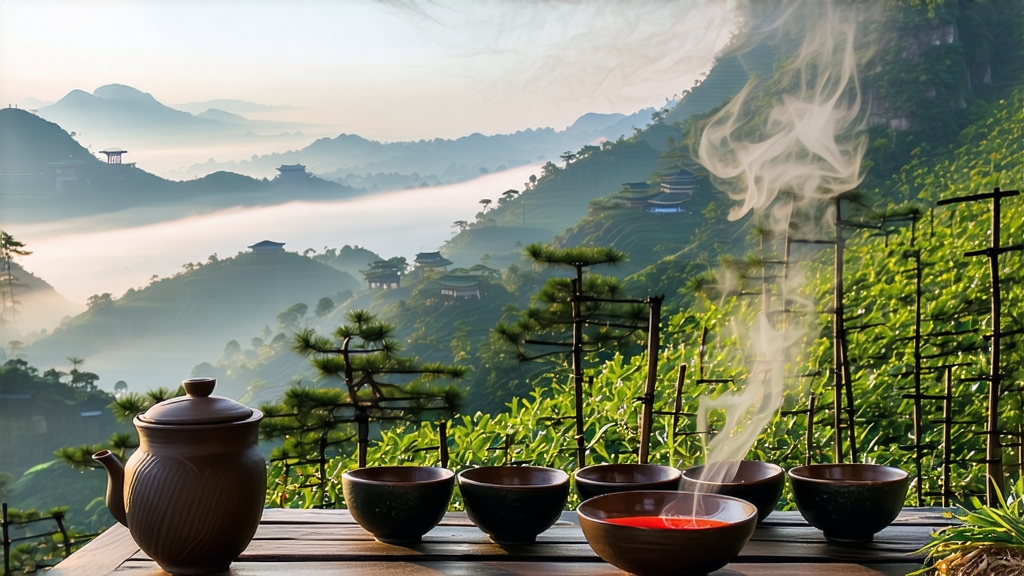
When European tea merchants first tasted a dark, honeyed leaf from the port of Xiamen in 1604, they labeled it “black tea,” giving the world a new category and a new word. The leaf they sipped was Lapsang Souchong, a tea so distinctive that its perfume of pine smoke and longan fruit would soon drift through London coffee-houses, Amsterdam parlors, and, eventually, the drawing rooms of St. Petersburg. Today, connoisseurs still argue whether the smoke is the soul or merely the garment of this tea, but no one disputes that Lapsang Souchong—literally “small sort from Lapu Mountain”—is the primogenitor of every black tea on earth.
Origin and Terroir
The story begins in Tongmu Guan, a protected enclave inside Fujian’s Wuyi Mountains where sheer cliffs, running mist, and a microclimate that swings from cool cloud forest to warm bamboo groves create an amphitheater of flavor. The Min River and its tributaries bring mineral-rich alluvium, while the constant humidity encourages slow, succulent growth in the indigenous Xiao Zhong cultivar. Because the gorge is too narrow for large tea gardens, bushes are scattered among pines, chestnuts, and wild azaleas; their roots compete with fragrant undergrowth, imprinting the leaf with resinous, floral notes long before any fire is lit.
Two Families, One Leaf
Within Tongmu Guan, two lineages guard slightly different styles. The “Old Bush” Lapsang is picked from arboreal tea trees 2–3 m tall, some over 300 years old. Their May harvest yields only a few hundred kilos a year, but the liquor is satin-smooth, layered with cacao, dried apricot, and a cool camphor finish that lingers like mint in a mountain breeze. The more widely available “Garden Style” comes from managed bushes pruned to waist height; it is brighter, maltier, and more amenable to the signature smoking process that made the tea famous overseas.
Craft: From Wok to Smokehouse
Plucking follows the Chinese rule of “one bud, two leaves, before the grain rains,” usually between Qingming and Guyu. Once picked, the leaves are withered on bamboo screens set over crackling pine embers—an initial, gentle warmth that starts enzymatic oxidation while impregnating the leaf with volatile pinene and borneol. Rolling comes next, done by machine in larger workshops but still by hand in family micro-factories: a rhythmic pressing and twisting that ruptures cells and releases catechins, preparing the leaf for transformation. Oxidation is carried out in wooden troughs lined with wet cloth; here, the leaf darkens from jade to copper within two hours, acquiring the malty sweetness that will balance later smoke. The critical step is the final drying over a pinewood fire inside a two-story Qing-dynasty smokehouse. Freshly sawn pine is stacked beneath iron pans; tea is spread on sieves above, absorbing smoke for six to eight hours while moisture drops to 3–4 %. Masters gauge readiness not with thermometers but by ear: when the rustle of leaves sounds like “walking on the first frost,” the tea is finished. A minority of producers now offer an unsmoked “Zheng Shan Xiao Zhong,” dried only with hot air, but purists insist that without the resinous kiss of Pinus massoniana, the tea has lost its birthright.
Grades and Nomenclature
European buyers once coined the term “Bohea” (from the local word “Wuyi”) for any dark leaf arriving at their warehouses. Today, grading is more nuanced. “Special Tongmu” consists of whole leaves with golden tips, delivering a clear, amber liquor and a scent of longan and pine sap. “Pekoe” grade is slightly broken, yielding a stronger cup favored in Russia for samovars. “Broken Lapsang” finds its way into scented blends—Earl Grey, Russian Caravan, or the smoky Moroccan “Gunpowder & Lapsang” mix—but the highest accolade remains “Tongmu Ji Pin,” a lot-numbered tea auctioned inside the village itself every June, often pre-sold to collectors in Singapore or Taipei.
Chemical Poetry
Gas chromatography reveals what the nose already knows: guaiacol, 4